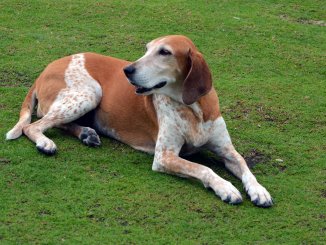The English foxhound is a medium-sized, purebred hound dog of English origin. English foxhounds are also commonly referred to as foxhounds.
These dogs make for good family dogs as they are very gentle with children and get along well with other dogs and animals. They are also easy to train and are low maintenance in terms of grooming.
English foxhounds typically cost $600 to $800 USD.
TABLE OF CONTENTS
What is an English Foxhound?

From Adobe Stock
The English Foxhound is an aristocratic, purebred hunting dog belonging to the hound group. Hounds refer to those dogs that were specifically bred to hunt, and who use their refined sight or scent to aid them.
They are an aesthetically beautiful breed with sleek muscularity and distinct features. English Foxhounds are known for their incredible sense of smell. They are equally known for their impressive stamina. This makes them the perfect hound for hunting parties.
They have a very rich and colorful history, dating back many years. The origin of this breed can be traced to the decline of the early stag hunts of the British aristocracy in medieval English forests.
As the number of stags eventually dwindled during the latter portion of the Middle Ages, the aristocracy transitioned to fox hunts. This change necessitated a different kind of hunting hound.
British fox hunts required a different breed that was capable of great stamina for these hunts, as well as an excellent sense of smell. The English Foxhound was bred for this need, thus earning them their current name.
Foxhunts, as they are recognized today, with their mounted horsemen and packs of dogs, can be first traced to the 1600s. Since the 18th century, the British Masters of Foxhounds Association has included this breed in their studbooks.
It is estimated that over the years there have been more than 250 packs of English Foxhounds in England. It is generally believed that Lord Fairfax brought the first pack of English Foxhounds to Colonial America in 1738.
The first U.S. President, George Washington, is credited as being instrumental in breeding the American Foxhound. Colonial Americans continued the long tradition of British style fox hunts in America.
In 1909, the American Kennel Club officially recognized the English Foxhound as its 62nd breed.
These beautiful high-energy hunting dogs are affectionate, athletic, intelligent, and gentle. With their high intellect and strong independent streak, they can occasionally become very stubborn. A proper dog training regimen is essential to instill proper obedience.
Experts note that a good training regimen must be firm, fair, and full of positive reinforcement. English Foxhounds usually appreciate food treats as a reward.
They are relatively healthy and can live for 10-13 years. As with all dogs, they are susceptible to certain medical ailments. Gastric torsion is one serious medical condition to watch out for which requires immediate medical attention.
English Foxhounds are rated as moderate shedders. They are considered low maintenance when it comes to their overall grooming requirements.
As a breed with high alertness, and a tendency to bark, they can make good watchdogs. You may enjoy their unique baying sound when they bark. Your neighbors may think differently.
For those equipped to deal with high stamina, high-energy dog, they can make a wonderful family pet. Although they are not generally regarded as house-pets, they have the temperament to become one.
This of course depends on you. Do you have the environment and personal temperament to keep up with their high energy requirements?
If the answer is yes, there are many great reasons to own this dog.
Appearance

From Adobe Stock
The English Foxhound has a very distinct look that may conjure up images of English aristocracy roaming the countryside on horseback for a foxhunt. Aesthetically, this is a very good looking dog.
They are known for their long, hanging, ears, big beautiful brown eyes, big chests, straight powerful legs, and a straight back. Their heads are often described as flat and “full-sized” sitting atop a long neck.
English Foxhound Weight and Size
Males average 22-25 inches in height. Females average 21-24 inches. They weigh on average 60-75 pounds.
Common Colors
They have a tri-colored coat composed of tan, white, and black. Other variations can be found in white and yellow, and on occasions may exhibit other colors.
Coat
Overall, the English Foxhound is regarded as a low maintenance dog. His glossy coat is hard, dense, and short. He exhibits moderate levels of shedding.
Personality and Temperament

From Adobe Stock
Behavior around other dogs
As pack animals, they behave exceptionally well with other dogs and animals. It should be noted though, that as animals bred to chase after prey, they may exhibit this behavior in the pursuit of smaller animals, particularly out in the wild.
It is best to socialize English Foxhound puppies to other dogs very early on. As with other breeds, this will help to cultivate healthy interactions with other animals.
Is an English Foxhound a Good Family Dog?
This is a very loving and friendly breed. Most importantly, they are known for being very gentle with children.
He makes an excellent pet for those equipped to accommodate his high energy requirements. The problem is that most families won’t be able to provide the necessary physical activity for this breed.
Some experts maintain that like other highly energetic dogs, they may not be ideal for those with very small children. This is solely due to the dog’s excitability and the possibility of a highly affectionate dog inadvertently knocking over a very small child.
As noted above, they are well-known for being gentle with children. Experts agree that they would never deliberately harm a child.
How to Train an English Foxhound
English Foxhounds are considered highly intelligent and are very eager to learn. They require firm but fair instruction with plenty of rewards and positive reinforcement. They have an independent streak and they may become stubborn. Overall, they are relatively easy to train, provided they have a fair and firm dog training program.
If you’ve done research online, you may have read that many experts recommend “crate training”. Since English Foxhound puppies can often be rambunctious and destructive, a crate is seen as an ideal way to protect both them and your valuables.
They have a tendency to chew and destroy things. The crate method protects your puppy’s welfare AND your home while training them when they are very young.
It is very important to start training early on when they are puppies and to keep it up until they mature. Obedience training is essential in order to ensure that you will have a well-disciplined dog.
Many experts recommend professional puppy training classes or obedience classes. If these are viable options, you should strongly consider them. As independent dogs with high energy, you want them to become very disciplined.
How To Care For an English Foxhound
From Adobe Stock
Exercise Requirements
As dogs that were originally bred to hunt down foxes in the British countryside for hours, they will benefit from high energy activities. Playing chase is a fun way to interact with this dog.
They should always be kept on a leash when they are not in a safe, open area. Without a leash, they may chase after things and even run into traffic if left unleashed. Take this into account whenever you take them for walks.
The English Foxhound requires approximately 30-60 minutes of intense activity each day. If they do not receive their required exercise they have a tendency to become depressed, destructive, and engage in other aberrant behavior.
This is a critical consideration to determine if this is the proper dog for you. If you can’t provide this dog with his needs, it will have an adverse effect on him.
This is not a good dog for an inactive owner, nor is it proper for the urban dweller. They require plenty of open space and are most suited for those living in the countryside. Suburbanites with a large home and large enclosed yard may also be suitable for this dog.
Grooming and Shedding
This is a low maintenance dog in terms of his overall grooming needs. They have short dense hair. Brushing them once a week with a hound mitt, cloth, or rubber brush should be sufficient. Brushing their hair properly will remove any loose and dead hair and minimize shedding.
English Foxhounds are considered to have a moderate level of shedding. An occasional bath is usually sufficient for this breed.
Bathe this breed only when they are really dirty or have a bad odor. Frequent bathing may lead to a decrease in the dog’s essential oils on his skin and hair. Consider using a shampoo specifically designed for dogs to retain the optimal moisture levels.
It is very important to periodically trim your dog’s nails. Left untrimmed, they can cause him discomfort and pain. It may eventually affect their mobility. Nails that are too long have a tendency to become splintered.
You will need to clean their teeth periodically, both in the home and to have it done professionally. Two to three times a week is an ideal number to prevent tartar and bacteria buildup, bad breath, tooth decay, or other infections. Be sure to use a veterinarian-approved toothpaste to ensure proper cleaning.
In addition to the damage to their teeth, dental ailments can also lead to serious infections. These in turn can lead to other more serious medical conditions affecting their bodies.
It is important to carefully check and clean their long ears to prevent wax build-up and ear infections. Their long ears should be kept free of excess moisture which is known for causing infections.
Don’t look at grooming as just a chore. Grooming is an excellent opportunity to bond with your pet. It is also a great time to observe and assess him for any signs of infections or other medical ailments.
An added benefit is that your dog will grow accustomed to physical touch. He will become more comfortable when he goes to the veterinarian for medical examinations in the future
What To Feed A English Foxhound
A healthy dog requires a proper diet of healthy dog food. One common tendency is that pet owners often start off with a disciplined diet for their dog, but over time become less disciplined in maintaining a strict diet.
Over time they sometimes grow careless and become less concerned with their pet’s diet. This may lead to feeding them inappropriate food or over-feeding them. Weight gain and obesity can lead to additional medical problems for your dog.
English Foxhounds require a diet that is rich in essential nutrients. They require the proper amount of proteins for their needs.
Proper feeding can either be commercially produced or homemade. You can find several quality brands on the market today. If you are going to go with homemade food, speak to your veterinarian to make sure the dietary needs of your pet are met.
Make sure to educate yourself about how to read nutritional labels, and what to look out for. Unnecessary filler material can be very unhealthy for your dog.
Other measures to ensure a healthy diet include setting a schedule for feeding your dog. This is done to avoid the stomach aches that plague some dogs as a result of irregular feeding schedules.
Puppies should be fed 3-4 times daily. Adult dogs should be fine with two feedings a day.
Make sure to feed your dog the proper amount of food throughout the various stages of his life. Additionally, you will want to provide access to plenty of clean and clear water.
Avoid the temptation to feed table food to your dog. Too much human food can be very bad for your dog’s health. Certain human foods are dangerous for dogs even in very small quantities.
Pet owners will need to consider the dietary requirements throughout the lifetime of their pet. The nutritional needs of a puppy are naturally very different from those of a full-grown dog.
A small puppy should not be given food for an adult dog. This can have adverse effects on his development.
Never underestimate the importance of a good diet. A proper diet and exercise will do much to ensure your dog’s overall health.
Known Health Problems
Generally speaking, this is considered a very healthy dog breed. Nevertheless, as with most dogs, there are specific medical conditions they are more susceptible to.
Their big chests make them vulnerable to Gastric Dilatation Volvulus, a serious condition also known as bloat. As with all dogs with long hanging ears, they are vulnerable to ear infections.
They have also been known to develop hip and elbow dysplasia. They may be susceptible to epilepsy, spinal disorder, and kidney disease. Some puppies are born with congenital deafness.
Hip Dysplasia: Hip Dysplasia is a medical condition that occurs when the dog’s femur isn’t properly attached to the pelvic socket. Over time, this can lead to considerable pain. This may be your earliest indication of the dog’s condition.
The inflammation will often lead to your dog developing a limp. It may ultimately result in the dog becoming lame.
Medical options to treat Hip Dysplasia include surgical and non-invasive alternatives. Initially, your vet will likely encourage you to reduce his exercise and level of physical activity to alleviate the condition.
If non-anti-inflammatory treatments prove to be unsuccessful, surgery may ultimately become necessary. Surgical hip displacement may be a final option if non-invasive measures are unsuccessful.
Elbow Dysplasia: Elbow Dysplasia is a degenerative condition where the dog’s elbow joints show abnormal development. The subsequent inflammation and pain increase the likelihood that your dog will become lame.
Gastric Dilatation Volvulus: The English Foxhounds’ large chest makes him susceptible to this serious condition. Also known as “bloat”, this is a very serious medical condition.
Bloat occurs when stomach torsions prevent the proper flow of blood to the heart. This is a life-threatening condition and it requires immediate medical attention.
As with many dogs with long pendulous ears, English Foxhounds have a tendency to develop infections. It is important that you regularly check and clean their ears to prevent wax build-up which can lead to infections.
The tendency of their ears to retain moisture is also considered a prime cause of infection. Use sterile gauze to properly clean the ear, preferably with a recognized ear-cleaning solution.
Epilepsy: This hereditary condition can lead to seizures. With the proper medications, your dog can live a long and healthy life. Unfortunately, medication can only control this condition but it cannot cure it.
English Foxhound and Water
Many owners report that their English Foxhounds are very fond of the water.
Buyer’s Guide

From Adobe Stock
How to Choose an English Foxhound Puppy?
First, you will need to find a reputable breeder. Experts agree that you should never purchase a puppy from a pet store, backyard breeder, or a puppy mill.
A proper breeder will always perform all of the necessary genetic tests to ensure your dog’s overall health. A responsible breeder will always let you observe and visit his facility. Naturally, the facility should be clean and hygienic. A dirty facility is a problem.
Ask to see the dog’s parents if at all possible. Inquire about the types of DNA tests that were administered to check for genetic disorders and other conditions. A good breeder will always provide you with the necessary medical documentation.
If he is unwilling to do this, you will want to look elsewhere. This applies to all important paperwork, whether it is medical or professional.
Find out what vaccinations (if any) your puppy received. Inquire which additional vaccinations will be required in the future. Ask the breeder how long it will be before you can take your pet home.
It is highly unusual for a new owner to take the puppy home that very same day. Find out his policy if your dog should experience serious genetic problems later on in life.
Make sure to ask the breeder any questions you have. Expect him to ask questions as well. A responsible breeder will want to ask you many questions of his own.
A breeder who truly cares about his puppy litter will want to ensure that his puppies find good homes. Don’t get annoyed if you feel like you are being grilled for an interview.
Inquire how long he has been a professional breeder. Ask the breeder if he is a member of a recognized dog breeding club. If yes, ask to see his paperwork confirming his membership. Additionally, make sure to ask him for official recommendations.
So how do you go about selecting the best puppy? Temperament is important in any puppy. A puppy with a good temperament will usually enjoy being held and will exhibit affection. They are usually very curious.
In the past, the classical advice was to choose the first cute puppy that came running to you. There are several downsides to this approach, which may prevent you from selecting the absolute best puppy for you.
For one, the other puppies in the litter might get overlooked if you fixate on the one who runs to you. A more subdued puppy may be more desirable. Many experts today recommend a different approach.
They recommend that you first assess the entire puppy litter. Observe any strange or aberrant behavior. See how they interact with one another as a group.
Only afterward, should you observe each individual puppy when it is separated from the rest of the litter? Puppies should always be checked for physical problems.
Make sure that each puppy looks healthy and is well maintained. A puppy that appears disheveled, dirty, or neglected is always a serious cause for alarm.
Check for physical abnormalities, inflammation, redness, infection, discharges, or areas of irritation.
- Check the animal’s coat. Is it clean and healthy? Is there bald or abraded patches? Are there abrasions or inflammations on the dog’s skin?
- Does the puppy walk with ease? Watch their gait for evidence of difficult or labored walking. Is there evidence of any problems with gait?
- Are the mucous membranes and other areas free of infections, swelling, discolorations, inflammations, redness, discharge, etc? Are the puppy’s groin and surrounding area free of abnormalities?
Professional breeders follow strict rules. If he doesn’t require you to sign a contract, you should become suspicious.
If he is willing to sell you the dog for considerably less than the market value, your radar should go off. If he is willing to bargain or haggle over the price you should be concerned.
How Much Do English Foxhounds Cost?
Considering their distinguished pedigree, English Foxhounds are considered to be a relatively inexpensive breed. They can cost approximately $600-$800 dollars from a reputable breeder.
They can occasionally be found at animal shelters. Sometimes this is due to the fact that owners are often remiss in researching this breed. When they realize that they made a mistake they experience buyers’ remorse.
When they find out that they can’t handle the breed’s requirements, they sometimes end up giving the dog to an animal shelter.
Adopting from an animal shelter is a great way to give an English Foxhound a second chance. A shelter will usually cost approximately $300. The cost at an animal shelter will cover the overall cost of the dog’s maintenance prior to his adoption.
Additional costs can include the following:
- The cost of feeding your dog throughout the various stages of his life.
- The expense of purchasing dog accessories and toys.
- The cost of obtaining proper pet insurance. (You could get reimbursed for every vet bill from now on! Save massively on your pet’s medical costs whether it’s an illness, injury, or wellness expense that needs taking care of.)
- Medical expenses: Medical costs will naturally include predictable, regular, periodic, veterinarian visits (for vaccinations, examinations, etc.) along with the cost of unpredictable procedures, surgeries, and medications that will arise throughout the lifetime of your pet.
English Foxhound vs American Foxhound
Although there are many similarities between the two dogs, there are critical differences between these types of Foxhounds.
| Trait | English Foxhound | American Foxhound |
| Herding dog | X | X |
| Physically Active | ✔ | ✔ |
| Loyal to their owners | ✔ | ✔ |
| Intelligent | ✔ | ✔ |
| Alert and responsive | ✔ | ✔ |
| Shedding | Moderate shedding | Seasonal/low maintenance grooming |
| Weight | 60-75 pounds. | Weight: MALE 65-70 pounds. FEMALE 60-65 pounds. |
| Exercise needs | High | High |
| Lifespan | 10-13 years. | 11-13 years |
| Health issues | Relatively Healthy: Bloat, Hip/Elbow Dysplasia, ear infections, epilepsy, and spinal disorder., congenital deafness | Relatively Healthy: Ear infections, hip dysplasia, thrombocytopathy |
| Training | Training should always be firm and fair/With their agreeable nature, they are relatively easy to train, although can be stubborn and independent. | Independent-may be stubborn |
English Foxhound Summary Table
| Pros | Cons |
| They are very friendly, loving, dogs. | They are susceptible to chest torsion, a serious medical condition. |
| They are good with children. | They are considered high when it comes to a tendency for wandering. |
| They are very intelligent. | They have a tendency to bark in a baying manner. This may annoy your neighbors. |
| English Foxhounds are beautiful. | They are not the proper dog for inactive people. |
| They have a long lifespan. | Although they are very gentle, as hunting dogs they retain a strong “prey drive”. |
| They are healthy. | Their long ears render them susceptible to ear infections. |
| They love to play. They are ideal for active owners. Runners and joggers will enjoy a highly energetic dog. | They are not suitable for urban dwellers or those living in apartments. |
| They are considered low maintenance. | As high energy hunting dogs bred for the chase, they should be kept on a leash when there is a concern that they will run into traffic. |
| They interact very well with other animals, including horses, cats, and dogs. | |
| They are good at participating in obedience or agility tests. |
Summary
We have tried to present you with essential information in order to determine if this is the proper dog for you. Now that you are armed with a fair amount of information, ask yourself: Is this the right dog for me?
You don’t have to be an aristocrat prowling the British countryside for foxes, in order to appreciate the English Foxhound. There is so much to love about this majestic purebred hound.
They have a wonderful temperament. These highly energetic beautiful dogs are affectionate, loyal, playful, intelligent, and confident. They are great with children. As pack dogs, they are unusually friendly with other dogs and animals.
English Foxhounds are considered low maintenance when it comes to grooming. Their level of hair shedding is considered moderate. They are a good dog for those with allergies since they don’t shed a lot.
They are generally healthy with few medical ailments. One of the more serious conditions to monitor for is gastric torsion which requires immediate medical attention. As with other dogs with big chests, this physical feature is often accompanied by a predisposition for this sudden and very serious medical ailment.
Additional medical things to look out for are hip and elbow dysplasia, ear infections, epilepsy, spinal disorder, kidney failure, and congenital deafness.
They are generally considered easy to train, although they may occasionally become stubborn. It is necessary to have a disciplined training regimen based on fairness and firmness. When your dog is still a puppy, you may want to consider crate training to protect him and to protect your home and valuables.
Patience is an absolute necessity along with consistency, firmness, and fairness. Treats can be effective as parts of a rewards system.
This is a very unique breed of dog. If you live in the countryside, a rural region, or a suitable suburban area, you will be able to offer this breed the necessary physical space he requires. We recommend the English Foxhound as a pet, but only for those rare owners who can meet the appropriate profile. If you have the energy to keep up with this dog and to provide him with sufficient daily exercise, this is an excellent pet.
FAQS
- Question: Are English Foxhounds known to bark a lot?
Answer: Yes. English Foxhounds have a tendency to bark in a unique manner called baying. This tendency, along with their overall alertness, makes them a great watchdog.
Note: Many owners really enjoy the unique baying of this fascinating animal. Your neighbors may not agree with you. In the ideal country-setting, this will probably be less of a problem.
- Question: I’ve been reading online that the English Foxhound is known as a scent hound. What does this mean?
Answer: Scent hounds use their incredible sense of smell to aid in the hunt. Foxhounds combine great stamina and power with a great sense of smell. There are other breeds of dogs that are known as sighthounds, who rely on their enhanced vision. As scent hounds, owners will need to remember that their dog has a tendency to chase after scents.
- Question: I live in a crowded city with a lot of traffic. Is this a good dog for me?
Answer: This is not a dog for someone living in a busy city or an urban area. They require either a country setting or a rural or suburban environment where they have a lot of room to run. Additional dangers of a city include the danger that your dog will run into traffic.
- Question: Do they have a tendency to dig?
Answer: Not really. This is a breed that is rated as having a low tendency to dig.
- Question: Do I need a special brush for my dog or any other equipment?
Answer: You don’t need any sophisticated grooming tools. A simple hound mitt, rubber brush, or rough cloth will usually be sufficient for your grooming needs.
- Question: Does this dog have a tendency to drool?
Answer: They are considered low when it comes to drooling.
- Question: I am a very active person and I live in a rural area. Is this a good dog for a first time dog-owner?
Answer: You meet certain criteria, but as wonderful as this breed is, he can be a serious challenge for a novice. Most experts don’t recommend this breed for an inexperienced person. Their high energy requires a lot of patience. And as loving and affectionate as they are, they will test even highly experienced dog-owners.
- Question: What’s the recommended amount of food to give him daily?
Answer: English foxhounds require approximately 2.5-3 cups of dried dog food on a daily basis. Puppies should be fed 3-4 times a day of proper food suited for their small developing bodies.
- Question: What kind of fox was the English Foxhound bred to hunt?
Answer: They were initially bred to hunt the red fox, following the loss of the larger stags that previous hounds hunted in medieval England’s forests. The traditional stag hunting parties declined and eventually disappeared with the decimation of the old-growth forests in the medieval period. The stags eventually disappeared as well.
- Question: What is a health clearance as it relates to a breeder?
Answer: A health clearance is a document that shows that the dog was tested and cleared of a particular condition. A responsible breeder will always be glad to show you all health clearances and general documentation relating to a dog.
Important health clearances include those from the Canine Eye Registry Foundation (CERF) and the Orthopedic Foundations for Animals (OFA).
- Question: Do these dogs like to be alone?
Answer: As pack animals that were bred to hunt, this is a breed that requires human and animal companionship.
- Question: What does it mean when I read about “a breed standard”?
Answer: These refer to the official criteria of the breed that the dog should meet to satisfy the recognized professional standards.
- Question: How often will I need to bathe my dog?
Answer: Very infrequently. Only bathe when your dog if he is truly dirty or if he has an odor problem.
- Question: I’m a lazy, inactive person but I really love this dog. Will that be a problem?
Answer: Absolutely. As noted above, this is a very high energy dog and he needs to run and be extremely active every day. It is unsuitable for most active people.
As a dog that was bred to hunt and still retains this inherent drive, they are only suitable for highly active people who like to hike, jog, or run every day, particularly in a country/rural setting. In certain situations where there are a big home and yard, certain suburban environments may be suitable as well.
- Question: Are English Foxhounds a common pet today?
Answer: Not at all. They are generally used by huntsmen in hunting clubs. They can make a great pet, but they require a very specific kind of owner. The American Kennel Club rates them as the least common dog today.
- Question: What are some differences between the American Foxhound and the English Foxhound?
Answer: There are many differences. American foxhounds are generally considered the faster of the two. The English Foxhound is said to have a better overall temperament, in terms of his affection and loyalty to his owner. He is stouter than his leaner American counterpart. Both are highly energetic hunters and capable of great stamina.
- Question: What does it mean when they say that a dog has “rounded” ears?
Answer: This refers to the unfortunate practice of surgically removing a part of the ear, which is considered illegal in certain countries today. There are certain prohibitions relating to a similar practice of cropping the tails of dogs.
- Question: Is the English Foxhound hypoallergenic?
Answer: No dog is ever truly hypoallergenic. Hypoallergenic generally refers to the fact that a certain breed is less likely to trigger allergic reactions in a person. The English Foxhound is a good example of a dog that is pretty good for those people who suffer from allergies. This breed is less likely to cause allergic reactions due to their moderate levels of shedding.
- Question: Which types of dogs were originally used to breed the English Foxhound?
Answer: The uniqueness of the English Foxhound is due to their mix of greyhound, terrier, bulldog, and other dogs. With the cessation of stag hunting in the later medieval period and the switch to fox-hunting, a new breed was deemed necessary for the aristocratic hunting parties.
- Question: How is this breed’s tolerance for extreme weather?
Answer: Most experts rate them as having moderate tolerance for cold and warm weather.








Be the first to comment